Sometimes it's hard to translate words from one language into another without losing a fair amount of its significance. This is one of those times, and the item at hand is cốm
(pronounced "kohm?" with an upward interrogative tone). Though this term is related to rice, don't mistaken it for the cơm that means cooked rice or a meal. On this occasion, we're talking about specially processed sticky (glutinous/sweet) rice grains. Above is a photo of young rice purchased at a Vietnamese market in San Jose.
A while back, Gail from Philadelphia, Pennsylvania, got me mildly obsessed about cốm when she asked about replicating some fried shrimp coated in com green rice that she'd enjoyed on a visit to Hue. About a month ago, Bill H. wrote asking about how to use some young/green rice that he and his wife purchased in Nha Trang.
To assist Bill (and anyone else who may have run into this ingredient), here are some details, originally posted years ago on the Viet World Kitchen website. I've also dusted off a fried shrimp coated with cốm green rice recipe.
What is Cốm?
It is freshly harvested sticky (glutinous/sweet) rice that's been toasted to bring out its delicate flavor. It can be eaten as is and out of hand. Because it's a precious commodity, connoisseurs recommend chewing on just a pinch at a time to truly savor the natural sweetness of the rice. Though the grains quickly lose their delicate qualities (some say within 24 hours!), Viet people enjoy them past their prime in other dishes. For example, they can be featured in rice cakes called bánh cốm, which often appear during special events like engagement ceremonies or Tet, made into ice cream, or suspended in a sweet dessert soup. The grains may stir-fried with sugar and oil, a preparation that sounds rich and dandy. They may also be popped and mixed with sugar syrup into a Vietnamese rice crispy treat. With the fried shrimp recipe presented here, you can also use cốm like breadcrumbs to create a wonderful coating for fried food. The cốm available abroad (see below) is okay but not a fair representation of what's in Vietnam.
Special Green Cốm
Com can come from different parts of Vietnam but there is one particular kind that's most prized - that from Vong village (Lang Vong) located on the outskirts of Hanoi, right off the highway and a few hundred meters from the Ha Pagoda. For northern Vietnamese, particularly Hanoians, com from Lang Vong has a special place in their hearts. The rice grown in that village is wonderfully flavored and fragrant, a unique artisanal product that's only grown and harvested in autumn by farmers of that village. Super fresh cốm from Vong village is considered the best. During com season, some people place a some on their ancestral altar as an offering.
According to archival records, Lang Vong has been making com green rice for at least 700 years. The process of growing, harvesting, and processing the rice is apparently a long-guarded secret of farming families of that village. It's been said that to keep the knowledge in the family, only sons and daughters-in-laws are taught how to make cốm. (Once married, a daughter has to go off to be with her husband and his family. If she revealed the family's secret to the in-laws, it could increase competition for her blood family's livelihood.)
What is public knowledge is that making cốm requires lots of work. For the best cốm, only grains of nep hoa vang, a variety of sticky rice that yields smallish round grains, is used. To check the readiness of the grains, the farmers pick and bite on some of the raw grains. If it tastes as sweet as milk, then it is harvest time. Grains that are too old won't have a nice green coloring. Grains that are too young will fall apart when pounded. The grains have be just right. Harvesting in the middle of the night is not uncommon. (These are committed people!)
The rice is hand harvested and then winnowed using a large, flat bamboo tray. The grains are then slowly dry roasted over a wood-fire and then transferred to a large mortar and pestle. Gentle, rhythmic pounding removes the husks from the grains, which are then winnowed and pounded again. (Extracted green juice from crushed young rice plants may be added during this process to yield a more vibrant green color.) The winnowing and pounding happens exactly seven (7) times to remove the husk. If there's too much pounding, the rice loses its green cask and turns brown. Once done, the finished com is carefully stored in layers of lotus leaves so that it may remain fresh and tender. Some people say that cốm is at its ultimate best within 24 hours of being processed. (Photos of com and how it is made are posted on the Nguoi Vien Xu website, which is in Vietnamese. Sorry.)
In the past, Lang Vong village was full of rice paddies and farmers devoted to cốm production. The economic growth of the 1990s has led to development in the village and the loss of farm lands. Writer Phu Duc notes:
For older Vietnamese, com has a sentimental value. In an essay called "Secrets of Com," Ham Chau reminds us of an old folk ballad that mentions places known for certain food ingredients and the value of the green rice:
Soy sauce from Ban and mint from Lang are the best.
And I did not know that you had married
Now the cốm I had kept for your wedding gift has turned moldy. . .
Perhaps much is lost in the translation, but the idea is there. Cốm is well regarded in Vietnamese foodways. With the rise in tourism in Vietnam, who knows, maybe the government or some creative entrepreneur will revive com production in Vong village.
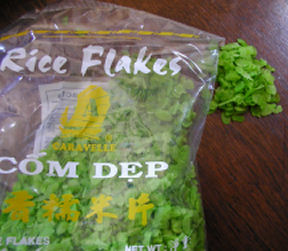
If you're lucky enough to have a connection in Vietnam, you may have cốm Lang Vong sent to you. (Apparently, there is a certain amount being produced. My mother recently received some.) Barring that situation, com is sold at many Vietnamese American markets in the form of com dep - flat com - which is dyed a rather brilliant green as a reminder of the wonders of great fresh com. The com sold abroad is labeled "rice flakes" and they resemble green oats. Vastly different from their original concept, the packaged stuff lasts a long time.













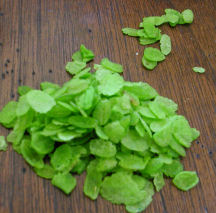

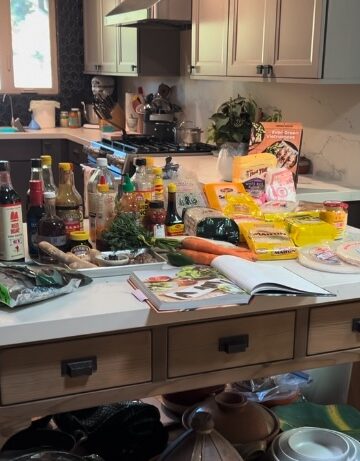
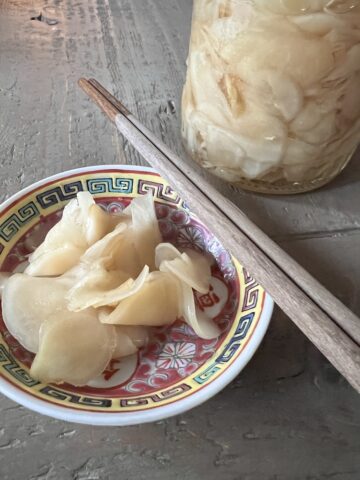
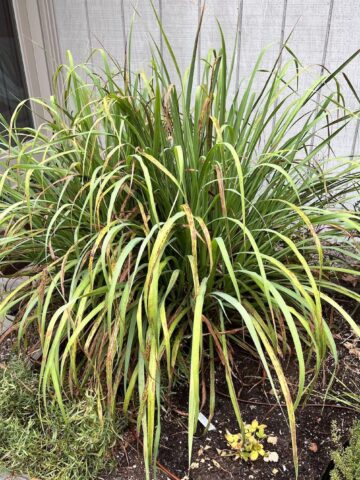
Diane says
How interesting! This seems very much like what the Indians call "poha," or pounded rice flakes. Poha is made from regular (not sticky) rice, and is not eaten raw. Rather it is used to make a savory breakfast food. I love poha, but the Vietnamese version seems more subtle and more interesting.
http://en.wikipedia.org/wiki/Poha_(rice)
http://vegetariandelight.wordpress.com/2006/10/04/poha-for-breakfast/
Robyn says
Hey Andrea - is that color natural? It seems almost artificially green.! I'm thinking we saw green rice in Hoi An but it was lighter. We've purchased green rice in Bangkok and Chiang Mai markets, and also here in Malaysia. But it's always sort of a pale green. Delicious stirred into slightly salted coconut milk and left to soften into a sort of porridge. (Better with palm sugar, of course.)
What time of year is the rice harvested and processed in Lang Vong, do you know?
Andrea Nguyen says
Hey -- yes, Diane! I've seen Poha but not tried it out. Thanks for the links.
Robyn, the link above to the Viet website shows the rice to be sickly green -- not in a bad way but rather like wilted, old vegetables. You're so lucky to have access to the young rice. It's so cool that these aspects of rice cultures persist. I don't know about the time of harvest in Lang Vong. You know who would? Mrs. Dzoan in Saigon.
Jude says
Interesting post! In the Philippines, this is called "pinipig":
http://www.marketmanila.com/archives/pinipig-immature-rice-pounded-into-flakes
Tiny says
Most packaged bag varieties of com dep contain green food coloring, hence the difference in color from what many of you have seen in other countries. So yes, the green stuff is unnatural. It does make it look more appetizing though
Andrea Nguyen says
What's a little food coloring now and then? It's what you eat some of the time, it's what you eat all the time that matters. Go ahead and use the commercial com dep!
jordan 13 says
Your ideas about something is so cool and different,many I knew and many I haven’t known,so I am learning them,thanks.and stay them.
Ahmed Mohamed Mohamoud says
thank
iwould like to take part world green day so that please send me more information about the world green thanks
+25224420940
Beats by Dr Dre says
If you feel you need to hold on to the emotion for a little longer, that is OK.
Canada Goose sale says
Victory won't come to me unless I go to it.
Monster Beats says
Nothing dries sooner than a tear.
marlon says
Your ideas about something is so cool and different,many I knew and many I haven’t known,so I am learning them,thanks.
Com vong says
Well come visit my website :http://comvong.weebly.com/baacutenh-c7888m.html
Tam Hamilton says
Hello,
I am looking for the recipe of xoi com , that is a favorite breakfast or snack mix of com with shredded coconut and a sprinkle of sugar, As I remember from m'y childhood. I do not know of Il should steam thé com. Many thanks .Tam
Andrea Nguyen says
I think you have to since the com is usually dried.